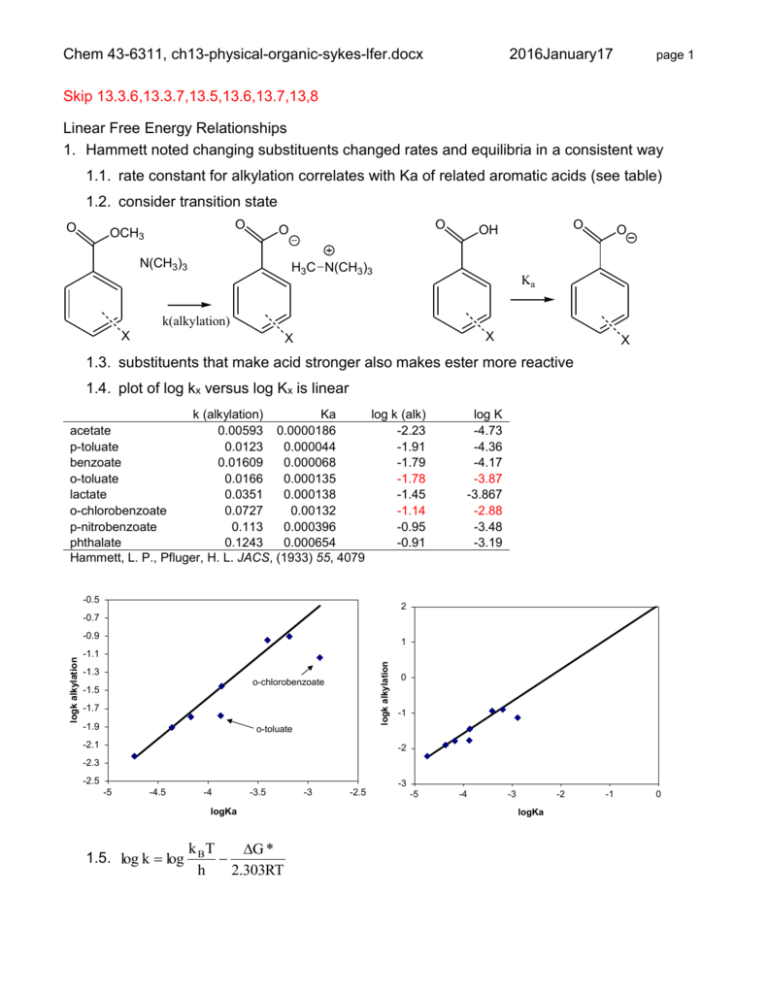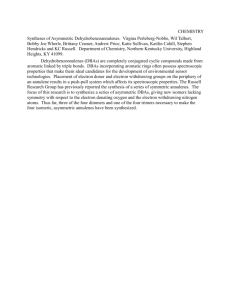Sykes CH13 Linear Free Energy Relationships
advertisement

Chem 43-6311, ch13-physical-organic-sykes-lfer.docx 2016January17 page 1 Skip 13.3.6,13.3.7,13.5,13.6,13.7,13,8 Linear Free Energy Relationships 1. Hammett noted changing substituents changed rates and equilibria in a consistent way 1.1. rate constant for alkylation correlates with Ka of related aromatic acids (see table) 1.2. consider transition state O O OCH3 O O N(CH3)3 O OH H3C N(CH3)3 O Ka k(alkylation) X X X X 1.3. substituents that make acid stronger also makes ester more reactive 1.4. plot of log kx versus log Kx is linear k (alkylation) Ka log k (alk) acetate 0.00593 0.0000186 -2.23 p-toluate 0.0123 0.000044 -1.91 benzoate 0.01609 0.000068 -1.79 o-toluate 0.0166 0.000135 -1.78 lactate 0.0351 0.000138 -1.45 o-chlorobenzoate 0.0727 0.00132 -1.14 p-nitrobenzoate 0.113 0.000396 -0.95 phthalate 0.1243 0.000654 -0.91 Hammett, L. P., Pfluger, H. L. JACS, (1933) 55, 4079 -0.5 log K -4.73 -4.36 -4.17 -3.87 -3.867 -2.88 -3.48 -3.19 2 -0.7 1 -1.1 logk alkylation logk alkylation -0.9 -1.3 o-chlorobenzoate -1.5 -1.7 -1.9 0 -1 o-toluate -2.1 -2 -2.3 -2.5 -5 -4.5 -4 -3.5 logKa 1.5. log k log k BT G * h 2.303RT -3 -2.5 -3 -5 -4 -3 -2 logKa -1 0 Chem 43-6311, ch13-physical-organic-sykes-lfer.docx 1.6. log K 2016January17 page 2 G o 2.303RT 1.7. logk linear with logK implies G* is linear withGo 1.8. changing the aromatic rings has a similar effect in changes between reactant and transition state for alkylation and reactant and product for acid dissociation 1.8.1. electron withdrawing groups favor increase in negative charge in TS or product 1.8.2. electron donating groups favor increase in positive charge in TS or product 1.9. substituents that increase Kx also increase kx 1.9.1. What does NO2 do? 1.10. ortho substituents don’t fit linear correlation 1.10.1. steric effect not same for proton abstraction 1.10.2. evidence of steric effect 2. equation for a straight line is y = mx + c 2.1. log kx = log Kx + C 2.2. for X = H: log kH = log KH + C 2.3. subtract 2.2 from 2.1: log kx - log kH = log Kx - log KH (eliminate C) 2.4. rearrange: log kx/kH = log Kx/KH 2.5. use dissociation of benzoic acids as standard reaction 2.5.1. let x = log Kx/KH : always refers to this reaction 2.5.2. x is a measure of electronic effects of X 2.5.3. x Hammett substituent constant, what is H? 2.6. log kx/kH = x 2.6.1. electron withdrawing groups have positive x 2.6.2. electron donating groups have negative x 2.6.3. the values indicate sensitivity to substituent changes relative to ionization of benzoic acid derivatives 3. other reaction rates and equilibria correlate with x 4. sign and magnitude of 4.1. ionization of benzoic acid derivatives by definition have =1 Chem 43-6311, ch13-physical-organic-sykes-lfer.docx 2016January17 page 3 4.2. reactions with positive (like benzoic acid ionization) have increase in electron density in TS (or product) 4.2.1. reaction half as sensitive to change in substituent O O = 0.47 OH H2O H2C H2C X OH3 O X O O = 1.00 OH H2O H3O O X X 4.3. reactions with negative have decrease in electron density in TS (or product) 4.3.1. reaction has reverse sensitivity to substituent electronic effect as benzoic acids 4.3.2. nearly twice as sensitive = -1.88 Ar CH2Cl Ar H2O CH2 kf Ar CH2OH Cl O O Ar = 1.00 OH H2O Ka Ar OH3 O Discuss boldface reactions. Reaction Type 1 ArNH2 + 2,4(NO2)2C6H3Cl k -3.19 2 ArNH2 + PhCOCl k -2.69 3 ArCH2Cl + H2O k -1.88 4 ArO- + EtI k -0.99 5 ArCO2H + MeOH (H+) k -0.09 6 ArCO2Me + H2O + (H+) k 0.03 7 ArCH2CO2H ionization K 0.47 8 ArCH2Cl + I- k 0.79 9 ArCH2CO2Et + H2O + (OH-) k 0.82 10 ArCO2H ionization K 1.00 11 ArOH ionization K 2.01 Chem 43-6311, ch13-physical-organic-sykes-lfer.docx 2016January17 12 ArCN + H2S (EtO-) k 2.14 13 ArCO2Et + H2O + (OH-) K 2.51 14 ArNH3+ ionization K 2.73 page 4 4.3.3. The effect can be in the transition state (product) and reactant 4.3.4. effect is usually much greater in one than the other (see 10 and 14) 4.3.5. the reverse process can have opposite sign of 5. Compare x 5.1. note values for meta and para substituents are not the same 5.2. methyl – electron donating 5.2.1. p-methyl: stronger effect via Hammett Substituent Constants resonance (more negative para) group 5.3. m-methyl has no resonance, less effect p m 1 O- -0.81 -0.47 2 OH -0.38 0.13 3 OMe -0.28 0.10 4 Me -0.17 -0.07 5 H 0 0 6 F 0.15 0.34 7 Cl 0.24 0.37 8 Br 0.26 0.37 overwhelmed by withdrawing 9 I 0.28 0.34 5.5.2. m-Cl has more withdrawing and 10 NH3+ 0.60 0.86 11 N2+ 1.93 1.65 5.4. p-methoxy, donor, withdrawing 5.4.1. lone pair resonance donation more important than electron withdrawing 5.4.2. m-methoxy, electron withdrawing dominates, poor resonance 5.5. Cl is electron withdrawing 5.5.1. p-Cl has donation but is less donation 5.6. N2+ is and withdrawing 5.7. Is para > meta? Not always, see 10 and 11 6. Sometimes logkX/kH do not fall on line, does not fit Hammett equation: substituents interact with reaction center differently than benzoic acids 6.1. some groups like NH2 can transfer electron density directly, while Me cannot 6.1.1. form double bond with nitrogen not carbon Chem 43-6311, ch13-physical-organic-sykes-lfer.docx NH2 NH2 CH2Cl CH2 NH2 NH2 CH3 CH3 CH2Cl CH2 CH2 CH2 page 5 CH3 Cl Cl Cl Cl Cl 2016January17 CH2 6.1.2. other reactions are insensitive to effect, there is no donation to reaction center NH2 NH2 NH2 Cl NH2R Cl NH2R RCl NH2 6.2. different substituents constants are used for through resonance reactions 6.2.1. + for electron donation by substituent to reaction center (as in 6.1.1) 6.2.2. - for electron withdrawing from reaction center (see below) N N NH O O O O O O 6.2.3. the magnitude of these new values vary depending on the reaction 6.2.4. every reaction has a somewhat different dependence on the substituents 6.2.5. dozens of substituent constants – no longer useful 6.2.6. only really work for aromatic compounds 7. learn most for the deviation from linearity Chem 43-6311, ch13-physical-organic-sykes-lfer.docx X OBs = OBs O3S 2016January17 page 6 brosylate acetolysis -4 Br -4.5 -5 -5.5 OBs log k -6 X X -6.5 -7 -7.5 HOAc -8 X OAc HOAc -8.5 -9 -0.4 0.1 0.6 7.1. two independent lines indicates change in mechanism 7.2. for most X, left mechanism applies, is small, X has small effect 7.3. right mechanism, is large, electrons of ring and X directly interact with reaction center 7.4. Why change over? 7.5. both reactions always occurs, one dominates over the other 7.6. Electron withdrawing groups slow down right reaction, becomes slower other reaction 8. Hydrolysis of esters 8.1. Acid catalyzed hydrolysis of methyl esters H2O/MeOH: = +0.03 Aac2 = 0.03 OH OH 8.2. Acid catalyzed hydrolysis of ethyl esters in 99.9% H2SO4: = -3.25 for low (ground state!) Ar OR Ar OH2 8.3. must be different mechanism, Aac1 8.4. for larger , = 2.0, change to Aal1 OR low = -3.25 O O 8.5. after protonation reaction center is positive, loss of alkyl increases electron density, accelerated by Ar high = 2.0 O O 9.1. = 2.67 for low (Ar has substituents) 9.1.1. the first step is fast so the second step RDS HOR H electron withdrawing group 9. Cyclodehydration of 2-phenyltriarylmethanol Ar OR R Ar 9.1.2. as the increases the second step gets faster because the charge density of the reaction center increases O H R Ar OH Chem 43-6311, ch13-physical-organic-sykes-lfer.docx 2016January17 page 7 9.1.3. at the same time the first step gets slower because the formation of the cation is inhibited by electron withdrawing group. 9.2. eventually the first step becomes RDS Ar 9.3. = -2.51 for high OH2 Ar 9.4. first step gets slower as increase because electron withdrawing groups inhibit formation of cation 9.5. concave down, (point is up) characteristic of change in RDS of single mechanism 9.6. concave up, characteristic of change in overall mechanism Ar Ar H Ar Ar









